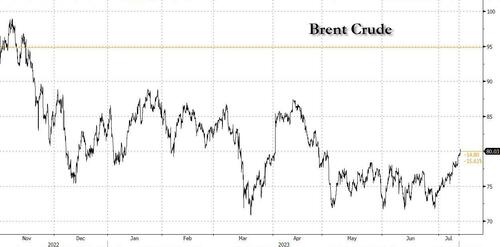
By Grant Smith, Bloomberg Markets Live reporter and strategist
After months of fruitlessly toiling to bolster global oil markets, OPEC+ is finally seeing some glimmers of hope as Brent prices near $80 a barrel in London. Whether they last is another question.
Oil-market intervention by Saudi Arabia and its partners this year has largely been met with indifference by traders: crude prices have sagged even as the cartel repeatedly slashes production, and even an extra 1 million barrel-a-day cut by the kingdom elicited little more than a shrug. The situation appears to be changing, as Brent futures approach $80 for the first time since May.
The US government’s Energy Information Administration has now flipped its outlook for 2023 as a whole from a surplus to a deficit. The crossover may have taken place as far back as early June, according to consultants FGE. The supply shortfall will more than double in the coming months, draining global oil inventories by a hefty 2.8 million barrels a day in August, Standard Chartered estimates.
The supply shortfall will more than double in the coming months, draining global oil inventories by a hefty 2.8 million barrels a day in August, Standard Chartered estimates.
In the physical market, there are clear signs that the OPEC+ curbs are starting to bite, as price differentials climb for crude grades similar to those shipped by the Saudis. Meanwhile, the Brent forward curve has returned to displaying a premium for immediate deliveries after flirting with a discount weeks ago, a symptom of renewed tightness.
OPEC is even getting more co-operation from its partner, Russia, which has frustrated the group with its reluctance to implement its agreed share of output cutbacks. Moscow has seemed intent on maximizing sales to fund its war against Ukraine, but tanker tracking shows the country pared exports by roughly 25% in the four weeks to July 9.
But it’s still too early for OPEC+ to celebrate. Even at $80 a barrel, prices are far below the $100-mark that Bloomberg Economics estimates the Saudis might need to cover government spending. Supplies in many corners of the market remain plentiful, and continue to rise from OPEC+ nations like Venezuela and the kingdom’s adversary, Iran.
Parts of Wall Street continue to sour on crude, with JPMorgan contending that OPEC+ needs to slash output by a further 700,000 barrels a day to regain market control. World markets will be inundated again with renewed oversupply in early 2024, Morgan Stanley warns.
To be sure, rising US interest rates have posed a severe headwind for prices this year, and if crude buckles in the face of the latest weaker inflation data, its prospects for a sustained move higher will look doubtful.
By Grant Smith, Bloomberg Markets Live reporter and strategist
After months of fruitlessly toiling to bolster global oil markets, OPEC+ is finally seeing some glimmers of hope as Brent prices near $80 a barrel in London. Whether they last is another question.
Oil-market intervention by Saudi Arabia and its partners this year has largely been met with indifference by traders: crude prices have sagged even as the cartel repeatedly slashes production, and even an extra 1 million barrel-a-day cut by the kingdom elicited little more than a shrug. The situation appears to be changing, as Brent futures approach $80 for the first time since May.
The US government’s Energy Information Administration has now flipped its outlook for 2023 as a whole from a surplus to a deficit. The crossover may have taken place as far back as early June, according to consultants FGE. The supply shortfall will more than double in the coming months, draining global oil inventories by a hefty 2.8 million barrels a day in August, Standard Chartered estimates.
The supply shortfall will more than double in the coming months, draining global oil inventories by a hefty 2.8 million barrels a day in August, Standard Chartered estimates.
In the physical market, there are clear signs that the OPEC+ curbs are starting to bite, as price differentials climb for crude grades similar to those shipped by the Saudis. Meanwhile, the Brent forward curve has returned to displaying a premium for immediate deliveries after flirting with a discount weeks ago, a symptom of renewed tightness.
OPEC is even getting more co-operation from its partner, Russia, which has frustrated the group with its reluctance to implement its agreed share of output cutbacks. Moscow has seemed intent on maximizing sales to fund its war against Ukraine, but tanker tracking shows the country pared exports by roughly 25% in the four weeks to July 9.
But it’s still too early for OPEC+ to celebrate. Even at $80 a barrel, prices are far below the $100-mark that Bloomberg Economics estimates the Saudis might need to cover government spending. Supplies in many corners of the market remain plentiful, and continue to rise from OPEC+ nations like Venezuela and the kingdom’s adversary, Iran.
Parts of Wall Street continue to sour on crude, with JPMorgan contending that OPEC+ needs to slash output by a further 700,000 barrels a day to regain market control. World markets will be inundated again with renewed oversupply in early 2024, Morgan Stanley warns.
To be sure, rising US interest rates have posed a severe headwind for prices this year, and if crude buckles in the face of the latest weaker inflation data, its prospects for a sustained move higher will look doubtful.
Loading…





